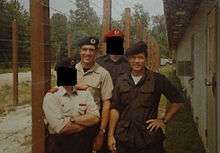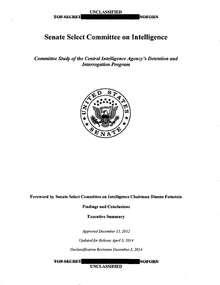Bruce Jessen

John Bruce Jessen (born July 28, 1949)[1] is a psychologist who, with James Elmer Mitchell, created the so-called "enhanced interrogation techniques" that were used in the interrogation of CIA detainees, as outlined in the United States Senate Select Committee on Intelligence's report on CIA torture.[2] In that report, he was mentioned under the pseudonym "Hammond Dunbar." His company, Mitchell Jessen and Associates, earned US$81 million for its work.[3]
Career
A United States Air Force retiree, Jessen, along with James Mitchell, was hired in 2002 by the Central Intelligence Agency to design the so-called "enhanced interrogation techniques" program.[4][5] The objectives of the program were not merely to obtain intelligence, but to also break down detainees in order to get them to be compliant and submissive to authority.[6]
In 2005, Jessen and Mitchell formed a company called Mitchell Jessen and Associates, with offices in Spokane and Virginia.[7]
On October 15, 2012, Jessen was sustained as bishop of the Spokane 6th Ward of The Church of Jesus Christ of Latter-day Saints.[8] He resigned as bishop one week later.[9]
CIA assessment on efficacy of EITs
On request by the National Security Advisor Susan Rice in 2015, the CIA compiled a summary of key intelligence collected after the application of (unspecified) interrogation techniques. In detail the memorandum lists intelligence related to the following topics: The Karachi Plot, The Heathrow Plot, The "Second Wave," The Guraba Cell, Issa al-Hindi, Abu Talha al-Pakistani, Hambali's Capture, Jafaar al-Tayyar, Dirty Bomb Plot, Shoe bomber, and Sh(a)kai (Pakistan). The CIA concludes that the enhanced interrogation techniques were instrumental in preventing Islamic terrorists from launching a spectacular attack against western targets after 9/11.[10]
Senate Intelligence Committee report on CIA torture

On December 9, 2014 the United States Senate Select Committee on Intelligence released a report confirming the use of torture and SERE tactics in interrogations.[11] The contractors that developed the "enhanced interrogation techniques" received US$81 million for their services, out of an original contract worth more than US$180 million. NBC News identified the contractors, who were referred to in the report via pseudonyms, as Mitchell, Jessen & Associates from Spokane, Washington, which was run by two psychologists, John "Bruce" Jessen and James Mitchell. The report states that the contractor "developed the list of enhanced interrogation techniques and personally conducted interrogations of some of the CIA's most significant detainees using those techniques. The contractors also evaluated whether the detainees' psychological state allowed for continued use of the techniques, even for some detainees they themselves were interrogating or had interrogated." Mitchell, Jessen & Associates developed a "menu" of 20 enhanced techniques including waterboarding, sleep deprivation, and stress positions. John Rizzo, CIA acting general counsel, described in his book Company Man, that the techniques were "sadistic and terrifying."[12]
Lawsuit
In 2014, The New York Times Editorial board called for the investigation and prosecution of Mitchell and Jessen for their role in developing the torture practices used by the CIA.[13] In 2015, Human Rights Watch called for the prosecution of Jessen "for [his] alleged direct participation in torture, often applied in ways beyond how it was authorized, but also for [his] role in the initial conspiracy to torture as well."[14]
On October 13, 2015 the American Civil Liberties Union filed a lawsuit against James Mitchell and Bruce Jessen on behalf of Mohamed Ahmed Ben Soud, Suleiman Abdullah Salim, and the estate of Gul Rahman, three former detainees who were subjected to the interrogation methods they designed.[15] The suit alleges that the defendants' conduct constituted torture and cruel, inhuman, and degrading treatment; non-consensual human experimentation; and war crimes – "all of which are violations of 'specific, universal, and obligatory' international law norms, as evidenced by numerous binding international treaties, declarations, and other international law instruments".[16] A trial was set for June 2017.[17] On July 28, 2017, U.S. District Judge Justin Lowe Quackenbush denied both parties motions for summary judgment, noted that the defendants are indemnified by the United States government, and encouraged the attorneys to reach a settlement before trial.[18] A settlement was reached in August 2017.[19]
See also
References
- ↑ U.S. Public Records Index, Vols. 1 & 2 (Provo, UT: Ancestry.com Operations, Inc.), 2010.
- ↑ Roger Aldrich, the Al Qaeda Manual, and the Origins of Mitchell-Jessen, American Torture August 25, 2009
- ↑ "'Flat Wrong': Big-Bucks Torture Teacher Slams CIA Report - NBC News".
- ↑ Shane, Scott (August 11, 2009). "Interrogation Inc. - 2 U.S. Architects of Harsh Tactics in 9/11's Wake". New York Times. Retrieved 2009-08-12.
- ↑ Report of the Committee on Armed Services United States Senate – Inquiry into the Treatment of Detainees in U.S. Custody April 22, 2009
- ↑ "Jason Leopold Interviews Former SERE Instructor Capt. Michael Kearns About The Bush Administration's Torture Program - The Public Record".
- ↑ "The Story of Mitchell Jessen & Associates: How a Psychologists Helped Develop CIA Torture Techniques".
- ↑ Camden, Jim (October 18, 2012), "Mormon church appointee aided CIA on terror", The Spokesman-Review
- ↑ Brooks, Joanna (October 23, 2012), "Does Romney's Religion Condone Torture?", Religion Dispatches
- ↑ "Effectiveness of the CIA counterterrorist interrogation techniques". CIA. 13 June 2016.
- ↑ United States Senate Select Committee on Intelligence. "The Senate Committee's Report on the C.I.A.'s Use of Torture" December 9, 2014.
- ↑ Windrem, Robert. "CIA Paid Torture Teachers More Than $80 Million". Archived from the original on 9 December 2014. Retrieved 9 December 2014.
- ↑ "Prosecute Torturers and Their Bosses". The New York Times. 2014-12-21. Retrieved 2015-04-17.
- ↑ "No More Excuses: A Roadmap to Justice for CIA Torture". hrw.org. Human Rights Watch. Retrieved 2015-12-02.
- ↑ McLaughlin, Jenna (October 13, 2015). "Former U.S. Detainees Sue Psychologists Responsible For CIA Torture Program". Intercept. Retrieved March 30, 2016.
- ↑ "Salim v. Mitchell - Complaint". October 15, 2015.
- ↑ Nicholas Geranios (January 20, 2017). "Judge hints at trial for harsh interrogation suit". The Register-Guard. Associated Press. Retrieved January 20, 2017.
- ↑ Fink, Sheri (29 July 2017). "2 Psychologists in C.I.A. Interrogations Can Face Trial, Judge Rules". The New York Times. p. A18. Retrieved 29 July 2017.
- ↑ Fink, Sheri (17 August 2017). "2 Settlement Reached in C.I.A. Torture Case". The New York Times. p. A12. Retrieved 13 March 2018.
External links
![]()
- Larry Siems: Inside the CIA's black site torture room Guardian, 9 October 2017.
- CIA Psychologist's Notes Reveal True Purpose Behind Bush's Torture Program, Truthout, Jason Leopold, Jeffrey Kaye, March 22, 2011
- The Dark Desires of Bruce Jessen, the Architect of Bush's Torture Program, As Revealed by His Former Friend and Colleague, Andy Worthington, March 28, 2011
- Michael Otterman
- Torture Memos Link Lawyers and Psychologists, Vanity Fair, Katherine Eban, April 19, 2009
- The Story of Mitchell Jessen & Associates: How a Team of Psychologists in Spokane, WA, Helped Develop the CIA's Torture Techniques, DemocracyNow, April 21, 2009